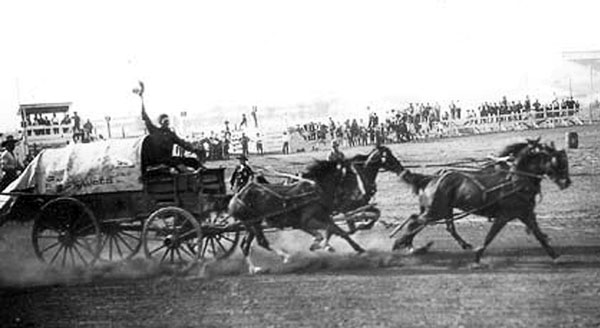
A Cowboy’s Poet
When I opened the package on my desk I found a small book. It had been wrapped in plain brown paper and white string and tucked inside was a typed note that stated, “Thought you might enjoy reading this.” There was no senders name or return address.
The book’s blue linen cover and gold lettering of the title, “Those Other Days” had seen some wear. Taped to the inside front cover there was a fragile yellowed newspaper obituary and an inscription in fading blue ink. Self published in 1969; the book is 102 pages of cowboy poems written by Alberta rancher Ray Bagley.
The obituary explained that Ray (Raephael Venearz) Bagley was born in a cabin near Sidney, Iowa in 1880 and died in Calgary in 1973. He was a horseman, cattleman and poet. In 1892 Ray and his parents George and Mary Bagley along with three siblings migrated by covered wagon through Nebraska, the Dakotas and Emerson, Man., to homestead near Lacombe, Alta. Ray married Elizabeth Swanson in 1902 and they homesteaded near Joffre east of Red Deer along the river. They had seven children in all. One son, Alex, became a guide and outfitter based at the Crows Nest Ranch and another son Bill (William) managed the Brewster horse remuda at the Kananaskis Ranch.
In the 1920s Ray raised Thoroughbreds. Sons Jim, William and Parley all jockeyed before their teens. The race horses got broke to ride through daily use as the only way to get to school in those days was to ride there and back. In the early 1920s Ray partnered with chuck wagon driver Tom Lauder who used several Bagley Thoroughbreds to pull Tom’s wagon, winning the Calgary Stampede and Edmonton in 1924?—?the first driver to win both cities in one year. They also won at Edmonton in 1925.
When the Great Depression hit in the 1930s, Ray, Elizabeth and their youngest daughter Tessie moved to Onion Lake, Sask., with their livestock hoping for better conditions. With WWII the economy improved and they moved back to Alberta in 1942, this time to the Crows Nest Ranch west of Coleman. The military was recruiting and paying a dollar a day so it was hard to find cowboys to trail a herd. The cattle were shipped by train but over 100 head of horses were trailed out to Morley Flats by son Bill and his friend Ivor Clarke where they wintered over. The next spring they trailed south to the Crows Nest.

Ray was naturally insightful into human behaviour and about how ranching shaped peoples lives in distinct ways. That shows up in his poetry as he had a gift for writing in verse the stories characteristic of ranch life.
Ray was no stranger to hardship; they lost 12-year-old son Patrick when he was struck in the head with a hardball. In his book there is a poem called, “God Has Called My Baby.” He had little formal education but in the cabin at Crows Nest Ranch, Ray kept about 200 books on Canadian and American history near the small desk where he wrote his poems.
Although Ray began writing poetry in the 1930s this did not become known to the public until his nephew Claude Brewster, an outfitter for the Trail Riders of the Canadian Rockies, invited him in the early 1950s to take part in the trail rides and read poems as part of the nightly entertainment. The TRCR began in 1923 as a way of getting people out into the backcountry from the CPR hotels such as Banff Springs. Some of the early supporters were outfitters Jim and Bill Brewster and legendary guide Tom Wilson. Their trademark became the tepee and it still is today as the TRCR continue to venture into mountain places best seen from the back of a horse.
Ray had a dry sense of humour when he joked with riders or when he made ranch signs. His gate sign read:
“Hell hath no fury so they say, like a woman scorned, but anyway, close this gate for I am telling you, I get pretty damned fussy too.”
He sent out some of his writings in Christmas cards to numerous trail riders and by request eventually published his book, dedicating it to his son Bill and the Trail Riders of the Canadian Rockies.
By the time Ray had written the inscription on the inside cover of the book his hand was clearly getting shaky. It reads; “To Annie, the friend of a lifetime. Friendship is beyond price and a few flowers scattered along life’s pathways are far better than a wreath on the grave, Ray”. I have found no evidence as to who Annie was or why Ray gave her a copy of his book. That, like the identity of the person who gave me this copy, might have to remain a mystery.
Writing history is a lot like building fences because in both endeavours you are never really quite finished. Just when you think you have one mystery solved or the last gate hung another one shows up. My wife says I shouldn’t complain though, she calls that job security.
One of his most popular poems read around the trail rider’s campfire is entitled, “A Bright Eyed Filly” and it is featured in this issue of Canadian Cowboy Country.
